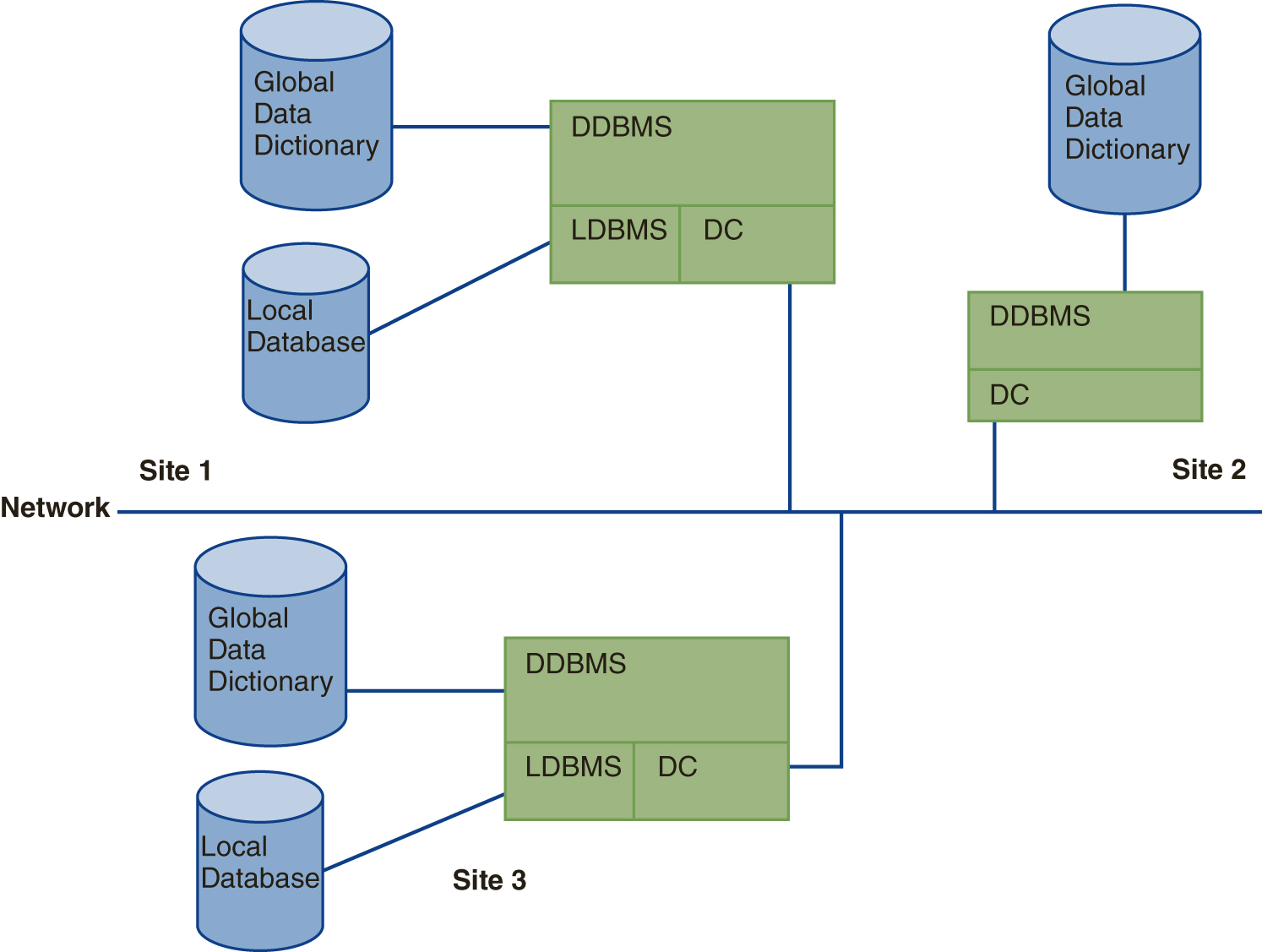12.3 Components of a Distributed Database System (DDBS)
A DDBS normally has the software components illustrated in FIGURE 12.5. Note that some sites contain all of these components, while others might not.

FIGURE 12.5 Components of a DDBS
Data communications (DC) component. The DC component is the software at each node that links it to the network. This DC component includes a complete description of the network’s nodes and lines. For each node, it identifies processing performed, storage capacity, processing power, and current state. For each link, it identifies the nodes it connects, type of link, bandwidth, protocols required, and the current state of the link.
Local database management system (LDBMS) component. The LDBMS component functions as a standard DBMS, responsible for controlling the local data at each site that has a database. It has its own data dictionary for local data, as well as the usual subsystems for concurrency control, recovery, query optimization, and so on.
Global data dictionary (GDD). The GDD is a repository of information about the distributed database. It includes a list of all data items with their location and other i nformation about data stored anywhere in the distributed system.
Distributed database management system (DDBMS) component. The DDBMS is the management system for the global database. It has many functions, including the following:
Provides the user interface. Location transparency is one of the major objectives of distributed databases. Ideally, the user need not specify the node at which data is located but acts as if all data is stored locally and accessed by the local DBMS. The local DBMS, however, is unaware of the distribution, so only requests that can be satisfied locally should be sent to the local DBMS. The DDBMS, therefore, intercepts all requests for data and directs them to the proper site(s).
Locates the data. After receiving a request for data, the DDBMS consults the global data dictionary to find the node or nodes where the data is stored. If the request can be filled entirely at the local node, it passes the query on to the local DBMS, which processes it. Otherwise, it must devise and carry out a plan for getting the data.
Processes queries. Queries can be categorized as local, remote, or compound. A local request is one that can be filled by the local DBMS. Local requests are simply handed down to the local DBMS, which finds the data and passes it back to the DDBMS, which in turn passes it to the user. Recall that the local DBMS has no user interface. A remote request is one that can be filled completely at another node. In this case, the DDBMS passes the request to the DBMS at that node and waits for the response, which it then presents to the user. A compound request, also called a global request, is one that requires information from several nodes. To process a compound request, the DDBMS decomposes the query into several remote and local requests that together will provide the information needed. It then directs each query to the appropriate DBMS, which processes it and returns the data to the DDBMS. The DDBMS then coordinates the data received to formulate a response for the user.
Provides network-wide concurrency control and recovery procedures. Although each local DBMS is responsible for handling update and recovery for its own data, only the DDBMS is aware of system-wide problems. Network-wide concurrency control is needed to prevent simultaneous users from interfering with one another. Network-wide recovery procedures are needed because, if a local node fails, although the local DBMS can recover its data to its condition at the time of failure, only the DDBMS can keep track of and apply changes made while the node was inactive. Preserving the essential characteristics of the ACID (Atomicity, Consistency, Isolation, Durability) properties for transactions in the distributed databases is a complex task that is handled by the DDBMS.
Provides translation of queries and data in heterogeneous systems. In heterogeneous systems with different hardware but the same local DBMS, minor translations of codes and word lengths and slight changes due to differences in implementation are needed. If the local DBMSs are different, major translation is needed. This includes changing from the query language of one DBMS into that of another and changing data models and data structures. If both hardware and DBMSs are different, both types of translation are needed.
